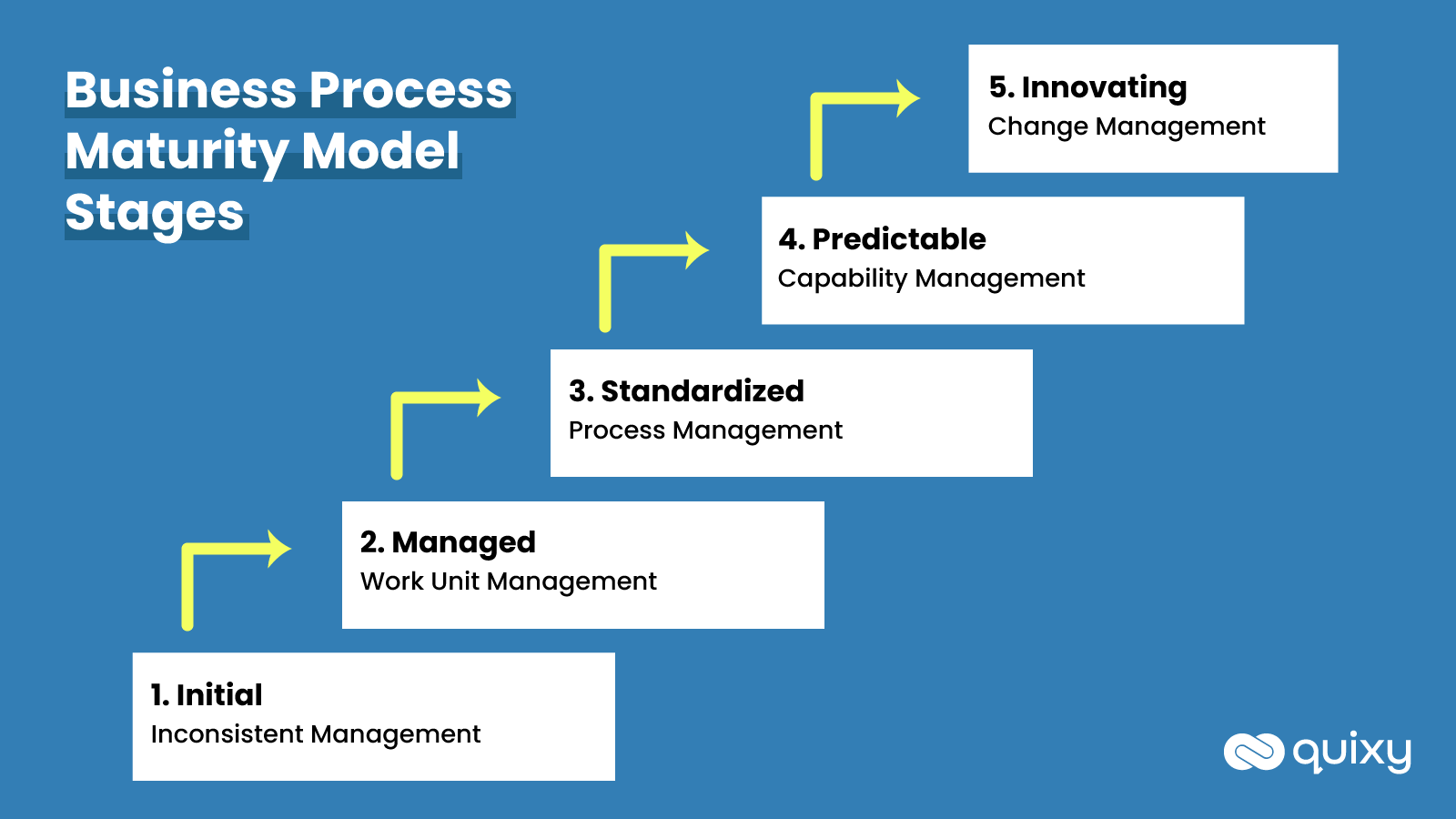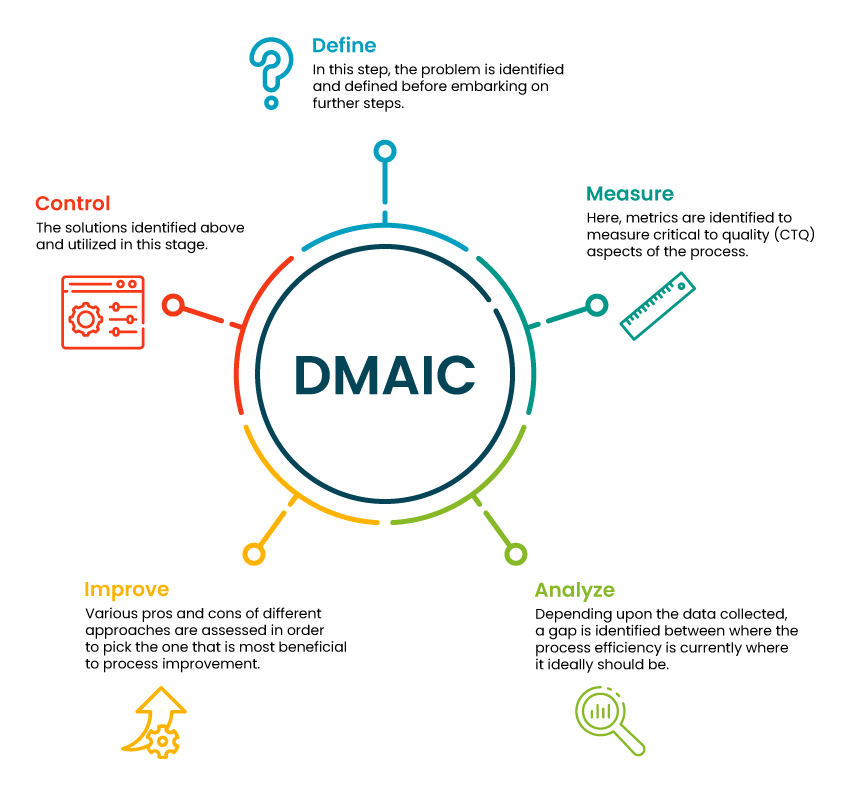
Any business, team, or system that you build needs a way to measure success. As you look at your performance, you should be able to set base standards that must be met. You should also be able to evaluate those standards with an understanding of what an ideal practice looks like.
It is important to know where you stand on that performance scale. The reason KPIs and OKRs are used is to track goals and objectives.
It is hard to apply those metrics to qualitative data, as useful as they are for some things. Using maturity models in this context can be extremely helpful.
Despite this, maturity models are often shrouded in complex terminology and overly complex structures. If people don’t understand it, how can I implement it in my business?
Let’s have a look at this article that will explain every detail about the business process maturity models.
What is a Maturity Model?
The maturity model measures an organization’s or system’s ability to improve continuously.
Your organization’s or system’s maturity can be measured by how well it improves itself. Overall, it’s about continuously assessing and improving your organization’s performance. It’s not like you’re standing still.
To achieve continuous improvement, you often need to create review or auditing processes that are applied to your day-to-day business operations to evaluate their effectiveness, identify improvements, and implement them.
Take your time, let the data roll in, and do it again. Maturity refers to how good your organization is at doing all of this and systematically doing it all.
Also Read: Top 15+ Business Process Automation Examples You Need to Know
What is a Business Process?
The term “Business Process” refers to the activities or sets of activities that are undertaken to accomplish a specific organizational goal. Business processes must clearly define goals, are as specific as possible, and produce consistent results.
Organizations evaluate a process’ success by tracking the completion of different steps within the process, i.e., benchmarks. Organizations can use several strategies to improve a business process and procedure when it fails to meet its goals or outcomes. To identify performance or execution issues, an organization might focus on business process visibility.
Also read: What is a Business Process? 7 Practical Examples
What is the Business Process Maturity Model (BPMM)?
By identifying immature, inconsistent business activities and developing mature, disciplined processes, the BPMM describes an evolutionary improvement path. Each stage of the BPMM provides a foundation on which to build improvements undertaken at the next stage.
In this way, it provides an improvement strategy for continuous process improvement. As a result, it identifies deficiencies in the organization’s processes and guides improvement steps in a logical, incremental manner.
Refining Principles for the Business Process Maturity Model (BPMM)
The guiding principles for the Business Process Maturity Model (BPMM) emphasize a process-centric approach with a focus on continuous improvement. These principles include aligning improvements with business goals, standardization, measurement, stakeholder involvement, documentation, training, technology enablement, and governance. By adhering to these principles, organizations can systematically enhance their processes, leading to increased efficiency and effectiveness in achieving their objectives.
Benefits of the Business Process Maturity Model
For all businesses to be successful, continuous improvements in efficiency and quality are essential. Organizations may be left to fumble in the dark without a method or framework for evaluating performance. Instead, they may be left to guide improvement efforts and resolve issues, wasting resources and opportunities.
BPMM serves four primary purposes:
- To propel business process improvement initiatives forward.
- To assess and mitigate risks associated with enterprise application deployment.
- To guarantee the selection of competent suppliers.
- To establish benchmarks for performance comparison.
A BPMM facilitates the measurement of process performance and evolution, as well as actions and next steps based on current conditions.
A maturity model, for example, has been used in implementing various business technologies for some time. Projects involving IT implementation carry many risks that can compromise the value of the application or even result in it being scrapped entirely – often at significant expense.
Business IT implementations often fail due to underlying weaknesses in the business processes targeted by the implementations. By providing clear guidance on improvement opportunities, BPMMs provide essential tools for evaluating organizational readiness for new applications in this context. In addition to IT implementations, business process evaluation is characteristic of continuous improvement efforts.
Also read: 10 Valuable Benefits of Business Process Management
Stages of Business Process Maturity Model(BPMM)
BPMM consists of five successive levels-

1. Initial
By encouraging people to overcome challenges and accomplish their tasks, BPMM level 1 aims to achieve economies of scale, automation, and productivity growth.
2. Managed
By managing work units and controlling workforce commitments, the second maturity level aims to develop repeatable practices, minimize rework, and satisfy commitments.
3. Standardized
BPMM’s third maturity level is focused on standardizing business processes, measuring results, and training staff.
4. Predictable
This maturity level focuses on improving processes, managing knowledge, reusing practices, and achieving predictable results. By standardizing processes and managing results quantitatively, organizations achieve these results.
5. Innovating
Organizations with the highest level of maturity focus on continuous improvement, developing efficient processes, and implementing innovative techniques.
Where does an organization go from one maturity level to another?
In terms of the degree to which processes are integrated and standardized, the five levels of maturity outlined earlier reflect the changes in an organization on its BPM maturity journey.
The Process Maturity Gap is a specific point in the BPMM journey where many organizations fail to transition. It is the difference between level two (where some processes are organized) and level three (where most processes are organized). A gap occurs when business processes break free of their silos and begin to form cross-functional, end-to-end processes when the organization can get everyone on board (buy-in), scale, and standardize.
Process Maturity
In terms of process maturity, it refers to the extent to which a development process is close to completion and capable of continuous improvement through qualitative measurements and feedback.
An effective process should be automated, data-driven, and continuously improving to be mature.
There are five levels of maturity for processes and activities, ranging from Level 1 (the least mature) to Level 5 (the most mature). Higher-level processes address lower-level features as well. Level 0 is where the activity does not have a process.

How to improve Business Process Maturity?
Using the Six Sigma DMAIC methodology (Define, Measure, Analyze, Improve, Control) is one way to improve all business processes:

Defining
Defining maturity levels is essential to aligning their applicability with an organization. Create a questionnaire to map each business process’ maturity level.
Measure
To determine each organization’s maturity level, a cross-functional team should be assigned. Using the questionnaire, the team should audit all activities and processes performed by the business.
It should be noted that if a process is at a higher level but does not meet some lower-level maturity criteria, the process will still be considered to be at the lower level (e.g., if a process is fully automated (Level 4) but not fully deployed, then it is considered to be at Level 2).

Analysis
To determine where the processes stand and where gaps exist, it is necessary to measure the processes. There is a need to address this issue. To bridge the gap and raise the maturity level of specific processes, an analysis needs to be conducted and a plan of action developed. This will improve the overall level.
Improve
This is the most important phase of the methodology. For the action plan to be effective, it must be implemented. It may include redefining or redesigning processes, identifying owners, automating processes, etc.
Control
Maturity levels can drop if processes are not monitored at defined intervals. Based on the control plan, subsequent audits of the maturity levels of processes must be conducted, and the processes must be improved in line with the audits.
Also read: 5 ways to drive Process Improvement in your Organization
Analyzing business-critical processes
A company must invest a great deal of time, effort, and money to improve its business processes. As a result, an organization would be better served by prioritizing business processes and developing business maturity gradually. An organization’s maturity is primarily determined by its business-critical processes.
The following steps can be taken to arrive at business-critical processes:
- Determine which areas the organization affects. As a general rule, it affects quality, timely delivery, compliance (regulatory/statutory/certification), cost, and people.
- Identify high-impact areas and develop a rating and weighing scale.
- All processes with high impact should be rated.
- By summing the ratings of the processes, we arrived at the total process criticality.
- Sort processes above the cutoff value based on the cutoff value.
What is the most appropriate model of business process maturity?
During this systematic literature review, the business process orientation maturity model (BPO-MM) and business process management capability framework (BPM-CF) were the most frequently referred to models in academic literature.
Despite the existence of many maturity models for the BPM field, their use in practice is limited. Therefore, the researchers used academic literature for their data, according to the review. According to the researchers, practical evaluations of BPMMs are rare, and these models are primarily designed for descriptive purposes. Thus, there is no single model that is both academically accepted and widely used in practice.
Nine BPMMs are known in academia that are put into practice:
- Framework for business process management capability (BPM-CF)
- Model of business process maturity (BPMM-FIS)
- Model of business process maturity for human resources (BPMM-HR)
- A maturity model for business processes (BPMM-OMG)
- A maturity framework for business process orientation (BPO-MF)
- A maturity model for business process orientation (BPO-MM)
- A maturity model for processes and enterprises (PEMM)
- Assessment of process management maturity (PMMA)
- Model of value-based process maturity (VPMM)
BPMM – Conformance
Conformance evaluation is about ensuring that the implemented system meets the client’s needs. To evaluate the performance of the practices in the BPMM, an effective appraisal technique is needed to verify conformance.
A Lead Appraiser authorized by the organization, trained in both BPMM and appraisal methods, should oversee the BPMM conformance appraisal. There should be some members of the organization on the team under the lead appraiser. As part of its conformance appraisal process, the BPMM conformance appraisal team collects and analyzes evidence regarding the implementation of BPMM practices. At each maturity level, it evaluates the strengths and weaknesses of the systems and gauges their effectiveness in meeting the goals of the process areas.
BPMM conformance appraisals utilize the following evidence:
- Analyzing the outputs of a process.
- An evaluation of the objects, documents, and products that support the execution of a process.
- An interview with a person who performs a process as well as the individual who supports and manages it.
- Data describing an organization’s state, employee behaviors, performance, and results.
BPMM Conformance Appraisals
Assuring that practices are implemented at a level that achieves the intent and goals of the practices and the process areas is the purpose of BPMM Conformance Appraisals.
There are four distinct types of BPMM conformance appraisals:
- A starter appraisal involves gathering quantitative data by conducting a few interviews and taking only a few days to complete.
- A progress appraisal is a comprehensive assessment that entails the collection and analysis of quantitative data, the investigation of all process areas and practices, the review of artifacts, and the analysis of interviews.
- In procurement contracts, supplier appraisal is one of the methods for selecting suppliers and making informed decisions.
- A confirmation appraisal is a rigorous investigation of all process areas/practices in which all evidence is considered.
Conclusion
This article explains what Business Process Maturity Models are, why you might use them, one of the key pitfalls, and a solution that would let you create a scalable single source of truth.
You can evaluate and track progress toward your target end-state using Business Process Maturity Models. It will help you prepare for, mitigate, and overcome the challenges you will face on your journey to process-centricity.
Frequently Asked Questions (FAQs)
What is Business Process Maturity Model?
The Business Process Maturity Model (BPMM) is a framework that assesses and classifies the maturity level of an organization’s business processes. It provides a structured approach to evaluate the effectiveness, efficiency, and repeatability of processes within an organization.
Why is the BPMM important for organizations?
The BPMM helps organizations understand the maturity of their processes and identify areas for improvement. It provides a roadmap for enhancing process capabilities, achieving consistency, and driving continuous improvement.
How does the BPMM measure process maturity?
The BPMM measures process maturity through five levels: Initial, Managed, Standardized, Predictable, and Optimizing. Each level represents a progressive improvement in process maturity, from ad hoc and chaotic to optimized and innovative.
What are the key characteristics of each BPMM level?
1. Level 1 – Initial: Ad hoc and unpredictable processes with no defined standards.
2. Level 2 – Managed: Basic process management practices and some level of consistency.
3. Level 3 – Standardized: Standardized processes across the organization, focusing on efficiency and consistency.
4. Level 4 – Predictable: Quantitatively measured processes, data-driven decision-making, and continuous improvement efforts.
5. Level 5 – Innovating: Continuous process optimization, automation, and a culture of innovation and excellence.
What are the 5 levels of process maturity model?
Initial: Processes are ad hoc, chaotic, and unpredictable, with little control or consistency.
Managed: Basic processes are established, documented, and followed, but results may vary.
Standardized: Processes are well-documented, standardized, and consistently executed across the organization.
Predictable: Processes are measured, monitored, and controlled using quantitative metrics to improve performance.
Innovating: Continuous process improvement is ingrained in the organization’s culture, with a focus on innovation and optimization.
Login
Please login to comment
0 Comments
Oldest
















